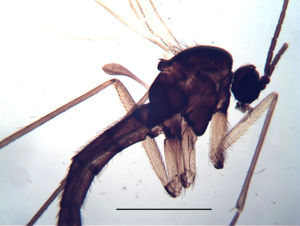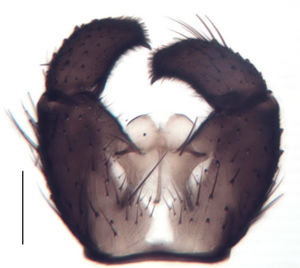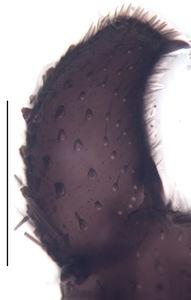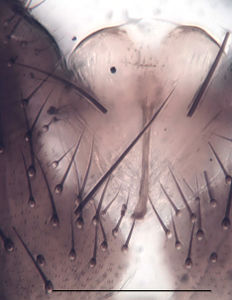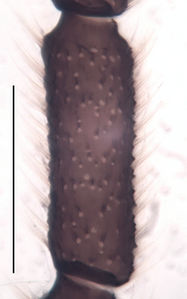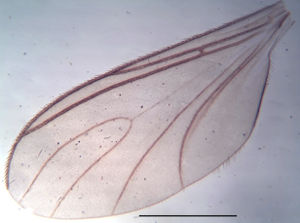Trichosiopsis fuscipalpa fuscipalpa
Ordo: Diptera
Familia: Sciaridae
Genus: Trichosiopsis
Species: Trichosiopsis fuscipalpa
Name
Trichosiopsis fuscipalpa fuscipalpa (Mohrig & Mamaev, 1979) – Wikispecies link – ZooBank link
- Trichosia (Leptosciarella) fuscipalpa Mohrig & Mamaev, 1979[1]: 575-576, fig. 4
- Leptosciarella (Leptosciarella) fuscipalpa (Mohrig & Mamaev, 1979)[2]: 64-66, fig. 12
Type material
Holotype: ♂, no date, leg. Mamaev in PWMP
Type locality
Russia, Danki near Moscow
Barcoded material studied
| Stadium | Country | Province | Locality | Habitat | Method | Date | Collector | Collection Number | Collection | Latitude | Longitude | Elevation (m) |
|---|---|---|---|---|---|---|---|---|---|---|---|---|
| 1 ♂ | Norway | Oppland | Oystre Slidre, Sandbakken V Ovre Heimdalen | Malaise Trap | 03.07.2012 | O. Gammelmo, O. & O.J. Lonnve | bf-sci-00056 | NHMO | 61,4306 | 8,83826 | 1110 | |
| 1 ♂ | Norway | Oppland | Oystre Slidre, Sandbakken V Ovre Heimdalen | Malaise Trap | 10.08.2012 | O. Gammelmo, O. & O.J. Lonnve | bf-sci-00085 | NHMO | 61,4306 | 8,83826 | 1110 | |
| 1 ♂ | Norway | Hordaland | Bergen, Floeyfjellet | 07.06.2014 | Kai Heller | bf-sci-00099 | NHMO | 60,395 | 5,343 | 333 | ||
| 1 ♂ | Norway | Sogn og Fjordane | Luster, | 06.06.2014 | Kai Heller | bf-sci-00139 | NHMO | 61,667 | 7,319 | 320 | ||
| 1 ♂ | Norway | Sogn og Fjordane | Luster, | 05.06.2014 | Kai Heller | bf-sci-00196 | NHMO | 61,447 | 7,466 | 105 | ||
| 1 ♂ | Norway | Vestfold | Larvik, | Malaise Trap | 27.05.2014 | Stefan Olberg | bf-sci-00313 | NHMO | 59,229 | 10,025 | 235 | |
| 1 ♂ | Norway | Vestfold | Larvik, | Malaise Trap | 18.06.2014 | Stefan Olberg | bf-sci-00373 | NHMO | 59,211 | 10,01 | 75 | |
| 1 ♀ | Norway | Sogn og Fjordane | Luster, | fjellbjoerkeskog | Sweep Netting | 06.06.2014 | O. Gammelmo & K.M. Olsen | bf-sci-00431 | NHMO | 61,667 | 7,319 | 320 |
| 1 ♂ | Norway | Telemark | Tinn, Svineroi V | Myrete fjellbjærkeskog med vierkratt. | Malaise Trap | 25.07.2012 | O.J. Lonnve | bf-sci-01042 | NHMO | 59,864 | 8,676 | 1005 |
| 1 ♂ | Norway | Telemark | Tokke, Tokke, NW Batsto Sandtak N veien | Lite sand- og grustak i morenemasse. Tett skog rundt. | Malaise trap | 09.06.2015 | O. Gammelmo & K.M. Olsen | bf-sci-01663 | NHMO | 59,4208 | 8,20839 | 85 |
| 1 | Norway | Sor-Trondelag | Trondheim, Sommerlystvegen 22 | Malaise Trap | 8.6.–8.6.2014 | E. Stur & T. Ekrem | BIOUG15596-A05 | NTNU | 63,405 | 10,383 | 65 | |
| 1 | Norway | Sor-Trondelag | Trondheim, Sommerlystvegen 22 | Malaise Trap | 8.6.–8.6.2014 | E. Stur & T. Ekrem | BIOUG15599-B02 | NTNU | 63,405 | 10,383 | 65 | |
| 1 ♂ | Norway | Troms | Storfjord, Storfjord, Gaelggojaervi, Pond W Myggbukta | Malaise trap | 15.6.–14.6.2016 | Jostein Kjaerandsen & M.T. Dahl | TSZD-JKJ-103703 | TSZD | 69,1256 | 20,7492 | 504 | |
| 1 ♂ | Norway | Troms | Storfjord, Storfjord, Gaelggojaervi, Pond W Myggbukta | Malaise trap | 15.6.–14.6.2016 | Jostein Kjaerandsen & M.T. Dahl | TSZD-JKJ-103706 | TSZD | 69,1256 | 20,7492 | 504 | |
| 1 ♂ | Norway | Troms | Storfjord, Storfjord, Gaelggojaervi, Pond W Myggbukta | Malaise trap | 11.7.–10.7.2016 | Jostein Kjaerandsen & M.T. Dahl | TSZD-JKJ-103727 | TSZD | 69,1256 | 20,7492 | 504 | |
| 1 ♂ | Norway | Troms | Tromsø, Skjelhollet, Kvaloy | Malaise trap | 28.6.–28.6.2015 | Jostein Kjaerandsen | TSZD-JKJ-103887 | TSZD | 69,768 | 18,851 | ||
| 1 ♂ | Norway | Finnmark | Alta, Gargia Fjellstue, 2.5 KM SE along road | SLAM trap | 10.7.–10.7.2014 | Jostein Kjaerandsen | TSZD-JKJ-103993 | TSZD | 69,789 | 23,521 | ||
| 1 ♂ | Germany | Schleswig-Holstein | Bilsen, Bilsener Wohld | Eichen- Kiefern- Buchenwald | Sweep Netting | 16.05.2013 | Kai Heller | ZFMK-TIS-14888 | ZFMK | 53,751 | 9,882 | 28 |
| 1 ♂ | Germany | Schleswig-Holstein | Heikendorf, Korügen | Buchenwald | Sweep Netting | 19.05.2013 | Kai Heller | ZFMK-TIS-14892 | ZFMK | 54,384 | 10,208 | 15 |
| 1 ♀ | Luxembourg | Dewenpetz | cave | Hand collecting | 12.05.2013 | Dieter Weber | ZFMK-TIS-2502027 | ZFMK | 49,76 | 6,31 | ||
| 1 ♂ | Germany | Brandenburg | Langer Berg, Grumsiner Forst | Wald | Malaise Trap | 8.5.–15.5.2013 | SDEI | ZFMK-TIS-2507135 | ZFMK | 52,982 | 13,914 | |
| 1 ♂ | Germany | Brandenburg | Langer Berg, Grumsiner Forst | Wald | Malaise Trap | 8.5.–15.5.2013 | SDEI | ZFMK-TIS-2507136 | ZFMK | 52,982 | 13,914 | |
| 1 ♂ | Germany | Brandenburg | Langer Berg, Grumsiner Forst | Wald | Malaise Trap | 8.5.–15.5.2013 | SDEI | ZFMK-TIS-2507137 | ZFMK | 52,982 | 13,914 | |
| 1 ♂ | Germany | Brandenburg | Langer Berg, Grumsiner Forst | Wald | Malaise Trap | 8.5.–15.5.2013 | SDEI | ZFMK-TIS-2507138 | ZFMK | 52,982 | 13,914 | |
| 1 ♂ | Germany | Brandenburg | Langer Berg, Grumsiner Forst | Wald | Malaise Trap | 18.6.–25.6.2013 | SDEI | ZFMK-TIS-2520472 | ZFMK | 52,982 | 13,914 | |
| 1 ♂ | Germany | Brandenburg | Langer Berg, Grumsiner Forst | Wald | Malaise Trap | 8.5.–15.5.2013 | SDEI | ZFMK-TIS-2520481 | ZFMK | 52,982 | 13,914 | |
| 1 ♀ | Germany | Mecklenburg-Vorpommern | Binz, Biosphärenreservat Südost-Rügen, NSG Granitz | 04.06.2016 | BioBlitz 2016 | ZFMK-TIS-2579041 | ZFMK | 54,3874 | 13,6481 | |||
| 1 ♂ | Germany | Mecklenburg-Vorpommern | Binz, Biosphärenreservat Südost-Rügen, NSG Granitz | 04.06.2016 | BioBlitz 2016 | ZFMK-TIS-2579053 | ZFMK | 54,3874 | 13,6481 |
.
Description (male)
Head. Eye bridge 4 rows of facets. Antenna unicolour. LW-index of 4th flagellomere 2.2–2.8; neck 0.3–0.36 × segment width; transition of basal part to neck pronounced. Colour of neck unicolour. Antennal setae shorter than segment width; fine; dense; adjacent. Palpus darkened; of normal length, or long; palpomeres 3. First palpomere of normal shape, or elongate; with 1–3 setae; with only sparse sensilla. Second palpomere short and oval. Third palpomere as long as first. Thorax. Colour brown. Notum unicolour. Thoracic setae long and strong; black. Posterior pronotum setose. Postpronotal setae 2–5; strong. Mesothoracic sclerites bare. Legs. Colour yellow. Hind coxa of same colour as femora. Setae on front coxa black. Front tibial organ as patch of setae; dark; front tibial organ not bordered. Tibial setae on hind legs weak and inconspicuous. Tibial spurs of equal length. Claws untoothed. Wing. Wing slightly darkened; of normal shape. Wing membrane without macrotrichia. Wing venation weak, with faint stM. M-fork of normal shape. R1 ending at or slightly before base of m-fork; posterior veins with macrotrichia; stM mostly with macrotrichia, or with a few macrotrichia; CuA1 and CuA2 mostly with macrotrichia; bM bare; r-m bare, or with few setae; bM:r-M 0.8–1; st-Cu:bM 0.45–0.6; R1:R 1.1–1.4; c:w 0.71–0.8. Halter darkened; of normal length. Abdomen. Abdominal setae strong; dense; on tergites black; on sternites black. Hypopygium concolour with abdomen; LW-index 0.6–0.8. Base of gonocoxites with weak setae, or with strong setae; gonocoxites broadly separated; inner margin of gonocoxites typically U-shaped; inner membrane of hypopygium scarcely setose; ventral margin of gonocoxite with short setae. Gonostylus elongate; LW-index 2–2.2; Inner margin concave; apex with one obtuse angle. Apical tooth present; without internal structure; of medium strength; LW-Index 1.8–2.2. Awl-like setae normal; present beneath apical tooth. Megasetae absent. Whiplash-hair absent. Tegmen 0.54–0.65 × longer than broad; rectangular with rounded edges; without special features; central process absent. Length of ejaculatory apodeme/hypopygium 30–38 %; base of ejaculatory apodeme present. Field with aedeagal teeth inconspicuous. Measurements. Body size 2.8–3.6 mm. Hind tibia 1.6–1.8 mm. Wing length 3–3.8 mm.
Diagnosis
The subspecies is primarily characterized by its unique COI sequence. It may also be recognized by a combination of the following characters: base of hypopygium with some longer setae; gonostylus apically with a distinct angle; antennae and legs long; legs shiningly yellow.
DNA Barcoding
The COI sequence is assigned to BIN BOLD:ACM7016 (average distance 0.27%, max. 1.12%, n=36, K2P: 3.69%).
Discussion
The barcoded specimens of Trichosiopsis fuscipalpa fuscipalpa are by the general aspect of the male genitalia most similar to the type specimen of Tr. fuscipalpa and are therefore considered to belong to the nominotypical subspecies, although the holotype is lacking the male genitalia. Contrary to the original description, where the legs are regarded as yellow-brown, they are in fact shiningly yellow. Also, DNA barcoding revealed, that the corresponding BIN for Tr. fuscipalpa fuscipalpa is the most widespread of all subspecies, so it is probable, that its distribution also extends to European part of Russia.
Distribution
Denmark, Germany, Luxembourg, Russia[1], Sweden, Norway.
Images
|
References
- ↑ 1.0 1.1 Mohrig, W.; Mamaev, B.; Krivosheina, N. 1979: Neue Arten holzverwertender Sciariden (Diptera) aus der UdSSR. Zoologische Jahrbücher, Abteilung für Systematik, Ökologie und Geographie der Tiere, 106, 572–588.
- ↑ Mohrig, W.; Menzel, F. 1997: Revision der paläarktischen Arten von Trichosia Winnertz sensu Tuomikoski, 1960 (Diptera, Sciaridae). – Teil II. Gattungen Leptosciarella Tuomikoski, 1960 und Trichodapus gen. nov. Studia dipterologica, 4(1), 41–98.
